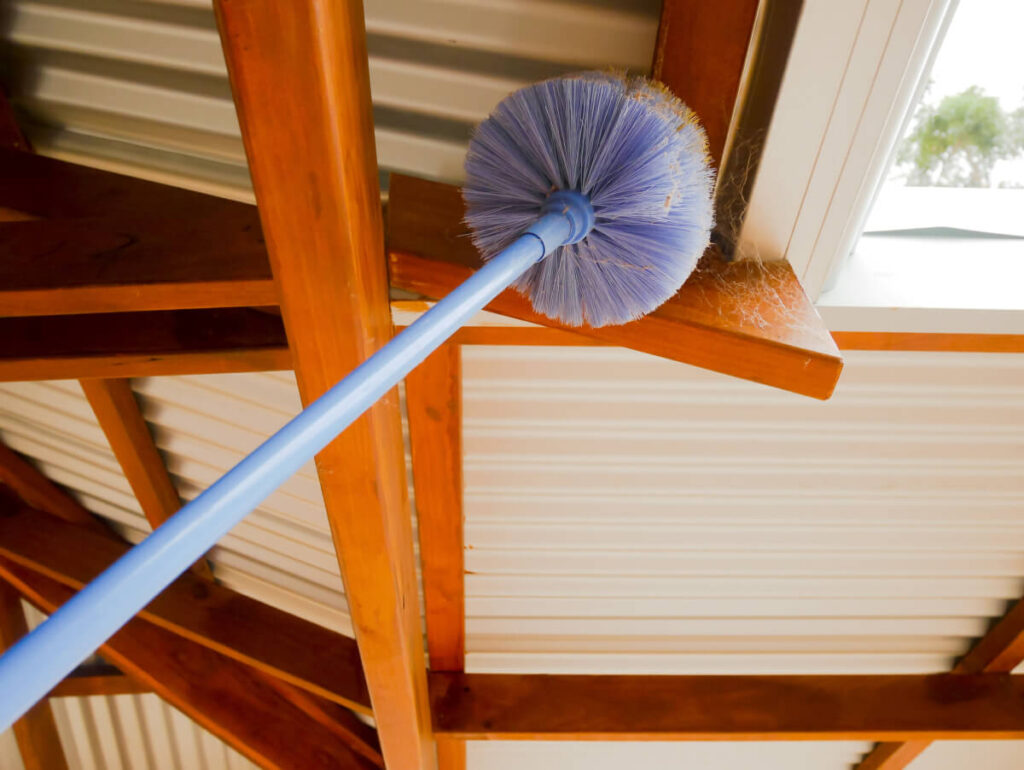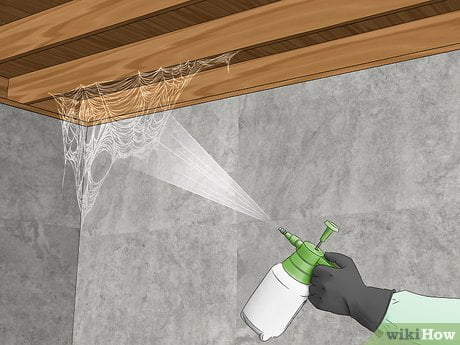The best way to remove spider webs is by using a vacuum cleaner or a long duster. These tools can effectively reach corners and ceilings where webs often accumulate.
Dealing with spider webs can be a nuisance for homeowners and cleanliness enthusiasts alike. A vacuum cleaner with an extension hose is ideal for sucking up webs and the spiders that create them, ensuring they don’t quickly reappear. For those high and hard-to-reach places, a long duster with a telescoping handle can swipe away the sticky strands with ease.
Regular cleaning reduces the likelihood of webs reoccurring. It’s important to keep an eye on less-frequented areas where spiders may prefer to spin their webs, such as in basements, garages, and seldom-used corners. Tackling spider webs promptly not only improves the cleanliness of your space but also discourages spiders from settling in. Remember to gently relocate any evicted eight-legged occupants to maintain a humane approach.
Introduction To Spider Web Challenges
Spider webs often appear in corners, on ceilings, and in other out-of-the-way places. While spiders play a role in nature, their webs can become a problem in our homes. Discovering the best methods to remove these silky snares is essential.
Why Spider Webs Can Be A Nuisance
Spider webs collect dust, dead insects, and debris. They stick to walls, ceilings, and furniture, creating unsightly scenes. Web removal must be careful to avoid spreading the mess.
- Collects dust and bugs
- Sticks to surfaces
- Creates cleaning challenges
Health And Aesthetic Concerns
Health risks may arise from spider webs. Allergens trapped in webs can affect sensitive individuals. Aesthetically, webs give an untidy look to spaces.
| Concern | Description |
|---|---|
| Allergies | Webs trap allergens |
| Look | Webs spoil home aesthetics |
Identifying Common Spider Web Locations
Spider webs are not just Halloween decorations. They are signs of spider activity. Knowing where spiders spin their webs is key to control. Let’s spot these common web locations.
Indoor Hotspots For Webs
Indoors, spiders favor quiet, undisturbed areas. Here’s where to check:
- Corners of rooms and ceilings
- Behind furniture and appliances
- Window frames and doorways
- Basements, attics, and garages
- Under sinks and inside cabinets
Outdoor Areas Prone To Spider Webs
Outside, spiders weave webs in various spots:
- Near light sources that attract prey
- Between plants, bushes, and trees
- Under eaves and overhangs
- Around windows and door frames
- Inside sheds and barns
Preventive Measures Against Webs
Are spider webs taking over your home or garden? You need effective preventive measures. Let’s explore some of the best strategies to keep spiders at bay.
Natural Deterrents For Spiders
Spiders dislike certain natural scents. These scents can keep them away.
- Peppermint Oil: A few drops mixed with water can be a spider repellent.
- Vinegar: A vinegar and water solution deters spiders when sprayed around the house.
- Citrus: Rubbing citrus peels on window sills and bookshelves can repel spiders.
- Chestnuts: Place chestnuts on windowsills and in corners to keep spiders out.
Maintaining A Clean Environment
A tidy space discourages spiders from making webs.
- Regular Dusting: Dust corners and crevices weekly.
- De-clutter: Less clutter means fewer places for spiders to hide.
- Seal Cracks: Close gaps in walls and foundations to prevent spiders from entering.
- Vacuum Regularly: Vacuuming removes spiders and their webs.
Essential Tools For Web Removal
Removing spider webs requires the right tools. Whether indoors or outdoors, certain tools make the task easier and safer. Below, find the essential tools for effective web removal.
Mechanical Tools
- Webster dusters: Long-handled dusters reach high corners.
- Extension poles: These poles allow you to reach webs without ladders.
- Vacuum cleaners: Use with a hose attachment for safe web suction.
- Broom: A simple broom dislodges webs effectively.
- Paint roller setup: Wrap with tape, sticky side out, to grab webs.
Safety Gear
- Gloves: Protect hands from dirt and potential spider bites.
- Safety goggles: Keep eyes safe from falling debris.
- Face mask: Prevent inhalation of dust and allergens.
- Long-sleeve shirt: Protect skin from irritants.
Choose tools that suit the web’s location and your comfort. Safety gear is essential for protection. With these tools, web removal becomes a simple task.
Manual Removal Techniques
Dealing with spider webs can be tricky. Yet, manual removal techniques offer a simple solution. These methods are safe and effective for indoor and outdoor webs. Let’s explore how to clean these sticky nuisances.
Step-by-step Guide For Indoor Webs
Indoor webs collect dust and make homes look dirty. Here’s how to remove them:
- Wear gloves to protect your hands.
- Attach a soft brush to a vacuum cleaner.
- Gently brush webs away with the vacuum.
- For high corners, use a long stick with a cloth tied around it.
- Wipe the area with a damp cloth to remove sticky residues.
Outdoor Web Removal Strategies
Outdoor webs are common in gardens and porches. Follow these steps:
- Use a high-pressure water hose. Aim directly at webs.
- For delicate plants, use a spray bottle with water instead.
- Prevent webs by keeping outdoor lights off when not needed.
- Trim bushes and trees regularly to reduce web-building spots.

Credit: www.reddit.com
Chemical Solutions For Persistent Webs
Dealing with spider webs can be tricky. Sometimes, a simple sweep isn’t enough. For those stubborn webs, chemical solutions may be the answer. Let’s dive into the best ways to tackle these with care.
Eco-friendly Sprays
Not all chemicals are bad for the environment. Eco-friendly sprays can help. These sprays are safe for pets and plants. They break down spider webs easily. You can make your own using vinegar and water. Mix one part vinegar to two parts water. Spray directly on the web. Wait a few minutes. Then, wipe or rinse the area. It’s simple and effective.
When To Use Stronger Chemicals
Sometimes, eco-friendly options may not work. This is true for large infestations. In such cases, stronger chemicals may be necessary. Always wear gloves and a mask for safety. Here’s a simple guide:
- Identify the type of spider. Some chemicals work better on certain types.
- Choose a chemical spray designed for spiders. Read the label carefully.
- Apply the spray during early morning or late evening. This is when spiders are most active.
- Follow the safety instructions on the product label.
Remember, using strong chemicals should be a last resort. Always try eco-friendly methods first. Keep your home clean and clutter-free to prevent webs.
Long-term Spider Control
Spiders may keep pests away, but their webs are unwelcome in our corners. Long-term spider control ensures a web-free home. Let’s explore how.
Regular Cleaning Routines
Clean homes deter spiders. They seek dusty, undisturbed spots for their webs. Regular dusting and vacuuming remove these tempting areas.
- Vacuum weekly, hitting corners and ceilings.
- Wipe surfaces with a damp cloth.
- Declutter to minimize spider hideouts.
- Inspect for webs during routine cleaning.
Stick to a cleaning schedule. This prevents webs and deters spiders from returning.
Professional Extermination Options
For persistent issues, consider professional exterminators. They provide expertise and effective solutions.
| Service | Benefits |
|---|---|
| Inspection | Finds spider sources |
| Treatment | Uses safe chemicals |
| Prevention | Offers long-term strategies |
Choose licensed professionals. They ensure safety and effectiveness.

Credit: www.wikihow.com
Conclusion: Balancing Control And Coexistence
Managing spider webs at home can be tricky. We want to remove webs but also respect nature. It’s about finding harmony. We can keep spaces clean without harming spiders. This final part offers tips to do just that.
Respecting Spider Ecology
Spiders play a key role in ecosystems. They control pests. Understanding this helps us manage webs better. We aim to disturb spiders as little as possible. Here are ways to respect their role:
- Identify areas where spiders help, like gardens.
- Limit web removal to key living spaces.
- Use gentle methods to clear webs outdoors.
Final Tips For A Spider-free Space
Clean homes can deter spiders. Follow these steps to reduce webs:
- Vacuum regularly, especially corners.
- Dust often to prevent web building.
- Seal cracks to block spider entry.
For webs out of reach, try this:
- Extendable dusters can reach high corners.
- Sticky traps catch spiders without mess.
Remember, spiders are not enemies. They are part of our environment. With these methods, we can live together in peace.

Credit: www.yalepest.com
Frequently Asked Questions
What Is The Safest Method To Remove Spider Webs?
Removing spider webs safely involves using a long-handled duster or vacuum with a brush attachment. Gently sweep or vacuum the webs away. This method prevents harm to you and minimizes damage to your walls or ceilings. Always wear gloves to avoid direct contact with spiders.
Can Vinegar Help In Taking Down Spider Webs?
Yes, vinegar can help in removing spider webs. Mix equal parts of water and white vinegar in a spray bottle. Spray the solution directly on the webs and the areas around them. The acidic nature of vinegar helps break down the web’s structure, making it easier to clean.
What Tools Are Best For Reaching High Spider Webs?
For high spider webs, telescopic dusters or vacuum cleaners with extension hoses are ideal. These tools can extend your reach without the need for ladders, making the process safer and more efficient. Ensure the tool’s head is soft to avoid scratching surfaces.
How Often Should You Clean Spider Webs From Your Home?
Regularly cleaning spider webs from your home is advisable every 2-3 weeks. This frequency helps prevent spiders from establishing permanent residences and keeps your living spaces clean. In areas with high spider activity, more frequent cleaning may be necessary.
Conclusion
Wrapping up, tackling spider webs doesn’t have to be daunting. Choosing the right method ensures your home stays web-free. Whether it’s with a vacuum or natural deterrents, consistency is key. Remember to clean regularly and seal entry points. Embrace these strategies for a cleaner, spider-free environment.
Related posts:

I’m MD Tanvir, and I bring years of expertise gained from working closely with pest control companies to the forefront. My journey in the industry has inspired me to launch Bug Battler, a platform aimed at equipping people with the know-how to combat pests autonomously. Through Bug Battler, I aim to empower individuals with practical insights to tackle pest infestations effectively.

